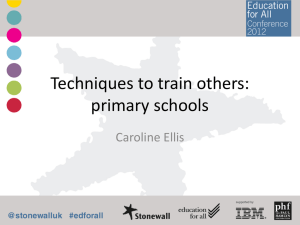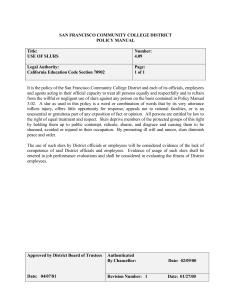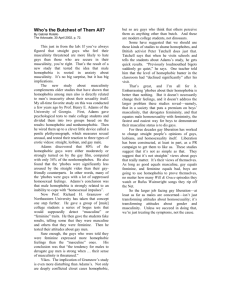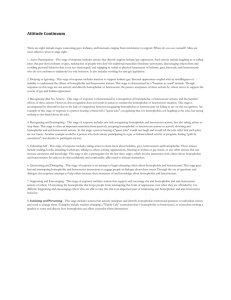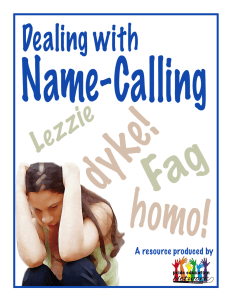Responding to Anti-Gay/Homophobic Slurs
advertisement
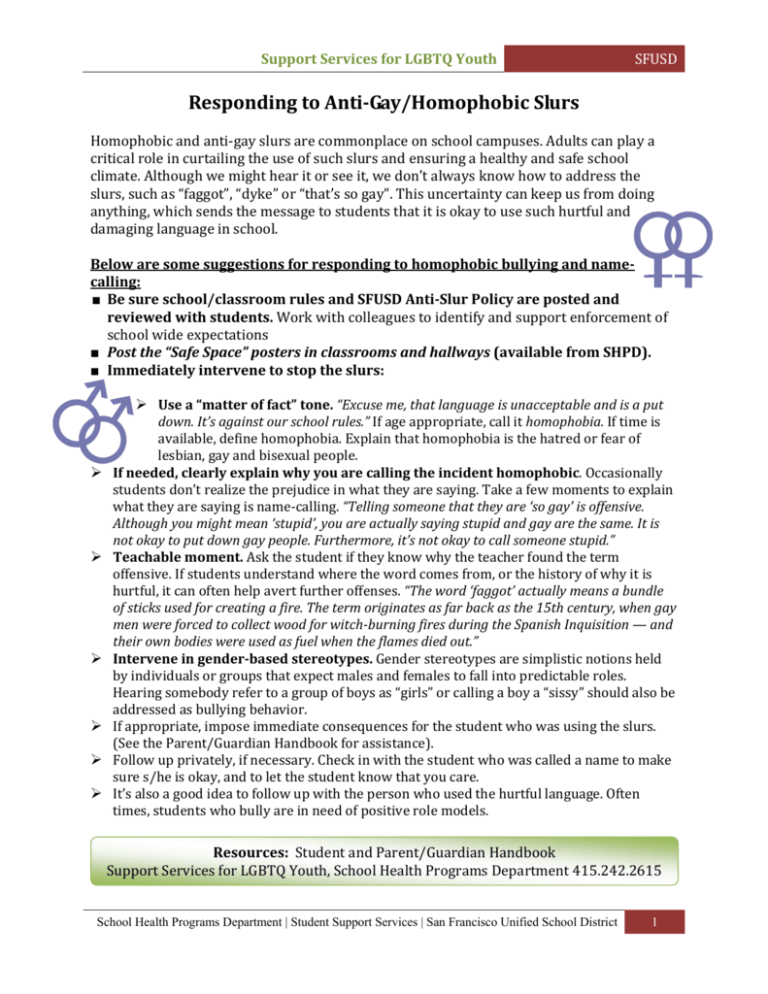
Support Services for LGBTQ Youth SFUSD Responding to Anti­Gay/Homophobic Slurs Homophobic and anti‐gay slurs are commonplace on school campuses. Adults can play a critical role in curtailing the use of such slurs and ensuring a healthy and safe school climate. Although we might hear it or see it, we don’t always know how to address the slurs, such as “faggot”, “dyke” or “that’s so gay”. This uncertainty can keep us from doing anything, which sends the message to students that it is okay to use such hurtful and damaging language in school. Below are some suggestions for responding to homophobic bullying and name­ calling: ■ Be sure school/classroom rules and SFUSD Anti­Slur Policy are posted and reviewed with students. Work with colleagues to identify and support enforcement of school wide expectations ■ Post the “Safe Space” posters in classrooms and hallways (available from SHPD). ■ Immediately intervene to stop the slurs: ¾ Use a “matter of fact” tone. “Excuse me, that language is unacceptable and is a put down. It’s against our school rules.” If age appropriate, call it homophobia. If time is available, define homophobia. Explain that homophobia is the hatred or fear of lesbian, gay and bisexual people. ¾ If needed, clearly explain why you are calling the incident homophobic. Occasionally students don’t realize the prejudice in what they are saying. Take a few moments to explain what they are saying is name‐calling. “Telling someone that they are ‘so gay’ is offensive. Although you might mean ‘stupid’, you are actually saying stupid and gay are the same. It is not okay to put down gay people. Furthermore, it’s not okay to call someone stupid.” ¾ Teachable moment. Ask the student if they know why the teacher found the term offensive. If students understand where the word comes from, or the history of why it is hurtful, it can often help avert further offenses. “The word ‘faggot’ actually means a bundle of sticks used for creating a fire. The term originates as far back as the 15th century, when gay men were forced to collect wood for witch­burning fires during the Spanish Inquisition — and their own bodies were used as fuel when the flames died out.” ¾ Intervene in gender­based stereotypes. Gender stereotypes are simplistic notions held by individuals or groups that expect males and females to fall into predictable roles. Hearing somebody refer to a group of boys as “girls” or calling a boy a “sissy” should also be addressed as bullying behavior. ¾ If appropriate, impose immediate consequences for the student who was using the slurs. (See the Parent/Guardian Handbook for assistance). ¾ Follow up privately, if necessary. Check in with the student who was called a name to make sure s/he is okay, and to let the student know that you care. ¾ It’s also a good idea to follow up with the person who used the hurtful language. Often times, students who bully are in need of positive role models. Resources: Student and Parent/Guardian Handbook Support Services for LGBTQ Youth, School Health Programs Department 415.242.2615 School Health Programs Department | Student Support Services | San Francisco Unified School District 1 Additional Tips for High School Classrooms 7 ways you can address Homophobic slurs Let the student know that you have LGBT friends or family and that you find what they said personally offensive. o “You know, I have good friends who are gay and lesbian, so I find what you just said to be really offensive.” Tell the student why what they said was inappropriate. o “What you just said was really inappropriate because you are implying that there is something wrong with being gay or lesbian when there isn’t.” Tell student to repeat what they said using more appropriate language. o “I need you to say that again without the hate language please.” Remind students that there is nothing wrong with being gay or lesbian. o “If you don’t like it, you should use a word that actually means something bad.” Teach students more sophisticated words to substitute for “that’s so gay” or “that’s fruity.” You could teach just one word, or several and have a poster on the wall to point to. Remind students that using slurs makes them look ignorant, while using more sophisticated terms will make them look smarter. Such words might include: lackluster, pedestrian, sophomoric, banal, asinine, facetious, etc. Then, when a student uses a phrase like “that’s gay,” have them restate it using one of the sophisticated words. Make a list of slurs with your students that they commonly use and hear. Talk about why they are wrong and about what kind of people might use those terms. Keep this banned words list handy, on the wall, etc. to remind students not to use them. Teach students the meaning of the word homophobic (irrational fear or hate of people who are LGBT), talk about the similarities between homophobia and racism, then remind them when they are being homophobic.



